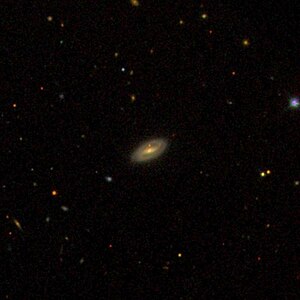NGC 905
| Galaxy NGC 905 |
|
|---|---|

|
|
| SDSS recording | |
| AladinLite | |
| Constellation | whale |
|
Position equinox : J2000.0 , epoch : J2000.0 |
|
| Right ascension | 02 h 22 m 43.6 s |
| declination | -08 ° 43 ′ 08 ″ |
| Appearance | |
| Morphological type | S0 + / Sy2 |
| Brightness (visual) | 15.1 mag |
| Brightness (B-band) | 16.0 mag |
| Angular expansion | 0.5 ′ × 0.3 ′ |
| Position angle | 115 ° |
| Surface brightness | 12.9 mag / arcmin² |
| Physical data | |
| Redshift | 0.045506 +/- 0.000094 |
| Radial velocity | 13,642 +/- 28 km / s |
|
Stroke distance v rad / H 0 |
(609 ± 43) · 10 6 Lj (186.8 ± 13.1) Mpc |
| history | |
| discovery | Francis Leavenworth |
| Discovery date | 1886 |
| Catalog names | |
| NGC 905 • PGC 9038 • 2MASX J02224355-0843080 • GALEXASC J022243.60-084308.0 • LEDA 9038 | |
NGC 905 is a lenticular galaxy with an active nucleus of the Hubble type S0 / a in the constellation Whale south of the ecliptic . It is estimated to be 609 million light years from the Milky Way and about 85,000 light years in diameter.
The object was by astronomer Francis Leavenworth use in 1886 of a 26-inch - telescope discovered.
Web links
Commons : NGC 905 - collection of images, videos, and audio files
